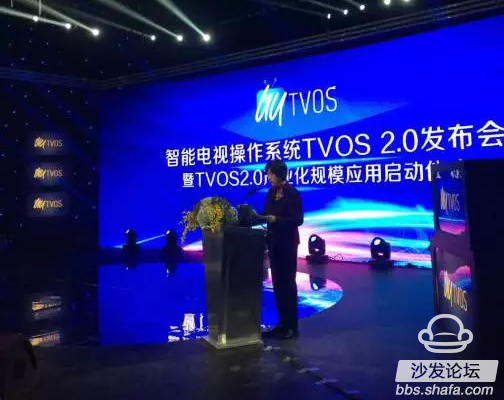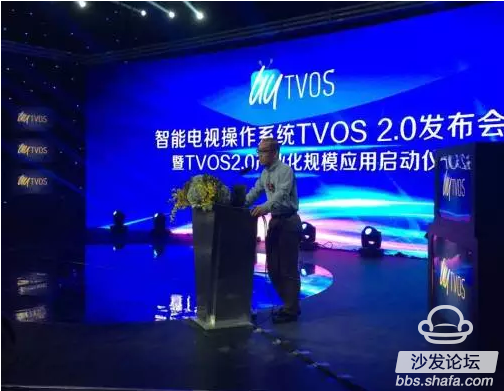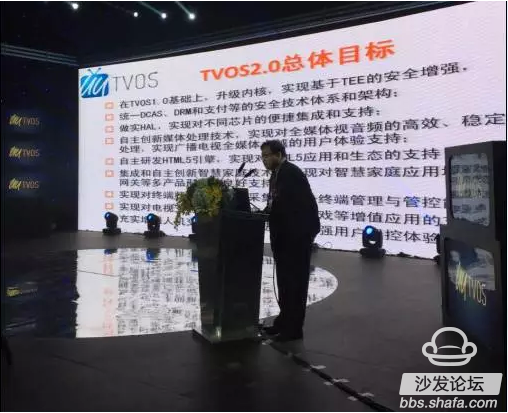On December 26, 2015, the Department of Science and Technology of the State Administration of Press, Publication, Radio, Film and Television, and the Department of Electronic Information of the Ministry of Industry and Information Technology held the launch event of the TVOS2.0 conference for smart TV operating systems and the application of TVOS2.0 industrialization scale in Changsha, Hunan Province.
At the conference, Wang Xiaojie, Director of the Science and Technology Division of the General Administration of Press, Publication, Radio, Film and Television stated that the smart TV operating system is the basic and key technology for the development of next-generation broadcast television. Its research and development and innovative applications have always been highly valued by the leading comrades of the Central Committee and published by the press. The strong support of the SARFT and the Ministry of Industry and Information Technology is of great significance for guaranteeing the safety of China's broadcast and television culture, supporting the integration and development of radio and television media, strategic transformation and upgrading, and promoting the sound development of China's smart TV industry.

Qi Yueshan, deputy director of the Electronic Information Department of the Ministry of Industry and Information Technology, also made recommendations on TVOS in his speech. He said that the work of smart TV operating systems should be further improved and TVOS 2.0 related functional modules should provide support for the innovation of smart TV products and speed up TVOS 3.0. R&D strives to be at the international advanced level in certain aspects.

Next, Sheng Zhifan, head of the TVOS working group of the smart TV operating system, introduced TVOS 2.0. According to General Sheng, the smart TV operating system TVOS 2.0 has broken through the key technologies for unified collaborative processing of live media, on-demand broadcasts, Internet television, and multi-screen interactive formats and formats, and built a powerful full-media collaborative processing. The mechanism, combined with the requirements of a unified all-media processing mechanism, created an autonomous and efficient HTML5 engine. Based on the hardware trusted security execution environment, a unified and coordinated security processing method was established for DCAS business protection, China DRM content protection, and online payment. The requirements of multi-modal smart TV terminals such as smart media gateways include built-in software function modules such as smart home services, media gateways, intelligent human-computer interaction, and big data collection, and successfully equipped with various value-added services such as video communications and video games. Can effectively support the set-top box, one machine, media gateways and other smart TV terminal form.

In addition to the release of TVOS 2.0, the conference also announced the establishment of a "Smart TV Operating System Working Group" and "Smart TV Industry Alliance." It is understood that the “Smart TV Operating System Working Group†is established on the basis of the existing “TVOS Cooperation Development Team Unit under the NGB Working Group Middleware and Smart TV Task Groupâ€.
It is reported that after the establishment of the working group, it was mainly believed that it is geared to the needs of the integration of China's radio and television media and the development of smart TV terminal related industries. The relevant companies and scientific research institutions within the United Nations have studied the key TVOS operating systems with independent intellectual property rights and advanced security mechanisms. , Develop system TVOS software, customize related technical standards, provide intelligent TV operating system technology and software for China's smart TV terminals, and serve the industrial application of China's radio and television intelligent terminals.
It is understood that the first batch of units participating in the “Smart TV Operating System TVOS Working Group†is 64, which are:
Academy of Broadcasting Science and Technology, Huawei Technologies Co., Ltd., Alibaba Cloud Computing Co., Ltd., ZTE Corporation, Shenzhen Skyworth-RGB Electronics Co., Ltd., Oriental Cable Network Co., Ltd., Jiangsu Radio and TV Cable Information Network Co., Ltd., Shaanxi Radio and TV Network Media (Group) Co., Ltd., Hunan Cable Television Network (Group) Co., Ltd., Hua Digital TV Media Group Co., Ltd., Hubei Radio and Television Information Network Co., Ltd., Shandong Radio and Television Network Co., Ltd., Sichuan Changhong Network Technology Co., Ltd. Company, Qingdao Hisense Electric Co., Ltd., Shanghai Lianhe Network Communication Technology Co., Ltd., Skyworth Digital Technology Co., Ltd., Shenzhen Haozhuang Network Co., Ltd., Sichuan Jiuzhou Electronic Technology Co., Ltd., Jiangsu Yinhe Electronics Co., Ltd., Baidu International Technology (Shenzhen) Co., Ltd., Leshizhixin Electronic Technology (Tianjin) Co., Ltd., Shenzhen Hisite Semiconductor Co., Ltd., Radio and Television Planning Institute, Institute of Acoustics, Chinese Academy of Sciences, Institute of Information Engineering, Chinese Academy of Sciences, China Academy of Software Research Institute, Morningstar Software R&D (Shenzhen) Co., Ltd., Shanghai Zhaoxin Integrated Circuit Co., Ltd., Beijing Digital Taihe Technology Co., Ltd., Shanghai Next Generation Radio and TV Network Application Laboratory Co., Ltd., Inspur Group Co., Ltd., Shenzhen Tong Chau Electronics Co., Ltd., Beijing Digital Video Technology Co., Ltd., Shanghai Panorama Digital Technology Co., Ltd., Beijing Ulead Pollock Technology Co., Ltd., Guangdong Guangdong Network (Beijing) Co., Ltd., Beijing Chaoge Digital Technology Co., Ltd., Shanghai Yingli Digital Technology Co., Ltd., 1905 Interactive (Beijing) Technology Co., Ltd., Beijing Secco Century Digital Technology Co., Ltd., Shanghai Yidian Digital Technology Co., Ltd., Shanghai Joli Media Technology Co., Ltd., Shenzhen Jiachuang Video Technology Co., Ltd., Guangdong Jiulian Technology Co., Ltd., Hunan Guoke Microelectronics Co., Ltd., Beijing Haier IC Design Co., Ltd., Hangzhou Guoxin Technology Co., Ltd., Tencent Technology (Shenzhen) Co., Ltd., and Konka Group Co., Ltd., Jiangsu Yunzhichuan Media Technology Co., Ltd., Panordi Electric (Shenzhen) Co., Ltd., Hangzhou Micron Technology Co., Ltd., Zhejiang Chuangjia Digital Technology Co., Ltd., ShangEqu Music Network Software (Shanghai) Co., Ltd., Shanghai Zhuo You Network Technology Co., Ltd., Beijing Visiontec Technology Co., Ltd., Beijing Boguang Tonglian Technology Co., Ltd., Beijing Yongxin Vision Digital TV Technology Co., Ltd., Beijing Taihe Zhiyuan Technology Co., Ltd., Beijing Zhongchuan Digital Technology Co., Ltd., Realtek Semiconductor (Shenzhen) Co., Ltd. Company, Jing Chen Semiconductor (Shanghai) Co., Ltd. (AMLogic), Shanghai HD Digital Technology Industry Co., Ltd., CNTV (China Internet TV).
At the conference, Wang Xiaojie, Director of the Science and Technology Division of the General Administration of Press, Publication, Radio, Film and Television stated that the smart TV operating system is the basic and key technology for the development of next-generation broadcast television. Its research and development and innovative applications have always been highly valued by the leading comrades of the Central Committee and published by the press. The strong support of the SARFT and the Ministry of Industry and Information Technology is of great significance for guaranteeing the safety of China's broadcast and television culture, supporting the integration and development of radio and television media, strategic transformation and upgrading, and promoting the sound development of China's smart TV industry.

Pictured: Wang Xiaojie, Director of Science and Technology, Press and Publication Bureau of Radio, Film and Television
Qi Yueshan, deputy director of the Electronic Information Department of the Ministry of Industry and Information Technology, also made recommendations on TVOS in his speech. He said that the work of smart TV operating systems should be further improved and TVOS 2.0 related functional modules should provide support for the innovation of smart TV products and speed up TVOS 3.0. R&D strives to be at the international advanced level in certain aspects.

Pictured: Deputy Director of Electronic Information Department, Ministry of Industry and Information, Qiao Yueshan
Next, Sheng Zhifan, head of the TVOS working group of the smart TV operating system, introduced TVOS 2.0. According to General Sheng, the smart TV operating system TVOS 2.0 has broken through the key technologies for unified collaborative processing of live media, on-demand broadcasts, Internet television, and multi-screen interactive formats and formats, and built a powerful full-media collaborative processing. The mechanism, combined with the requirements of a unified all-media processing mechanism, created an autonomous and efficient HTML5 engine. Based on the hardware trusted security execution environment, a unified and coordinated security processing method was established for DCAS business protection, China DRM content protection, and online payment. The requirements of multi-modal smart TV terminals such as smart media gateways include built-in software function modules such as smart home services, media gateways, intelligent human-computer interaction, and big data collection, and successfully equipped with various value-added services such as video communications and video games. Can effectively support the set-top box, one machine, media gateways and other smart TV terminal form.

Pictured: Smart TV operating system TVOS working group leader Sheng Zhifan
In addition to the release of TVOS 2.0, the conference also announced the establishment of a "Smart TV Operating System Working Group" and "Smart TV Industry Alliance." It is understood that the “Smart TV Operating System Working Group†is established on the basis of the existing “TVOS Cooperation Development Team Unit under the NGB Working Group Middleware and Smart TV Task Groupâ€.
It is reported that after the establishment of the working group, it was mainly believed that it is geared to the needs of the integration of China's radio and television media and the development of smart TV terminal related industries. The relevant companies and scientific research institutions within the United Nations have studied the key TVOS operating systems with independent intellectual property rights and advanced security mechanisms. , Develop system TVOS software, customize related technical standards, provide intelligent TV operating system technology and software for China's smart TV terminals, and serve the industrial application of China's radio and television intelligent terminals.
It is understood that the first batch of units participating in the “Smart TV Operating System TVOS Working Group†is 64, which are:
Academy of Broadcasting Science and Technology, Huawei Technologies Co., Ltd., Alibaba Cloud Computing Co., Ltd., ZTE Corporation, Shenzhen Skyworth-RGB Electronics Co., Ltd., Oriental Cable Network Co., Ltd., Jiangsu Radio and TV Cable Information Network Co., Ltd., Shaanxi Radio and TV Network Media (Group) Co., Ltd., Hunan Cable Television Network (Group) Co., Ltd., Hua Digital TV Media Group Co., Ltd., Hubei Radio and Television Information Network Co., Ltd., Shandong Radio and Television Network Co., Ltd., Sichuan Changhong Network Technology Co., Ltd. Company, Qingdao Hisense Electric Co., Ltd., Shanghai Lianhe Network Communication Technology Co., Ltd., Skyworth Digital Technology Co., Ltd., Shenzhen Haozhuang Network Co., Ltd., Sichuan Jiuzhou Electronic Technology Co., Ltd., Jiangsu Yinhe Electronics Co., Ltd., Baidu International Technology (Shenzhen) Co., Ltd., Leshizhixin Electronic Technology (Tianjin) Co., Ltd., Shenzhen Hisite Semiconductor Co., Ltd., Radio and Television Planning Institute, Institute of Acoustics, Chinese Academy of Sciences, Institute of Information Engineering, Chinese Academy of Sciences, China Academy of Software Research Institute, Morningstar Software R&D (Shenzhen) Co., Ltd., Shanghai Zhaoxin Integrated Circuit Co., Ltd., Beijing Digital Taihe Technology Co., Ltd., Shanghai Next Generation Radio and TV Network Application Laboratory Co., Ltd., Inspur Group Co., Ltd., Shenzhen Tong Chau Electronics Co., Ltd., Beijing Digital Video Technology Co., Ltd., Shanghai Panorama Digital Technology Co., Ltd., Beijing Ulead Pollock Technology Co., Ltd., Guangdong Guangdong Network (Beijing) Co., Ltd., Beijing Chaoge Digital Technology Co., Ltd., Shanghai Yingli Digital Technology Co., Ltd., 1905 Interactive (Beijing) Technology Co., Ltd., Beijing Secco Century Digital Technology Co., Ltd., Shanghai Yidian Digital Technology Co., Ltd., Shanghai Joli Media Technology Co., Ltd., Shenzhen Jiachuang Video Technology Co., Ltd., Guangdong Jiulian Technology Co., Ltd., Hunan Guoke Microelectronics Co., Ltd., Beijing Haier IC Design Co., Ltd., Hangzhou Guoxin Technology Co., Ltd., Tencent Technology (Shenzhen) Co., Ltd., and Konka Group Co., Ltd., Jiangsu Yunzhichuan Media Technology Co., Ltd., Panordi Electric (Shenzhen) Co., Ltd., Hangzhou Micron Technology Co., Ltd., Zhejiang Chuangjia Digital Technology Co., Ltd., ShangEqu Music Network Software (Shanghai) Co., Ltd., Shanghai Zhuo You Network Technology Co., Ltd., Beijing Visiontec Technology Co., Ltd., Beijing Boguang Tonglian Technology Co., Ltd., Beijing Yongxin Vision Digital TV Technology Co., Ltd., Beijing Taihe Zhiyuan Technology Co., Ltd., Beijing Zhongchuan Digital Technology Co., Ltd., Realtek Semiconductor (Shenzhen) Co., Ltd. Company, Jing Chen Semiconductor (Shanghai) Co., Ltd. (AMLogic), Shanghai HD Digital Technology Industry Co., Ltd., CNTV (China Internet TV).